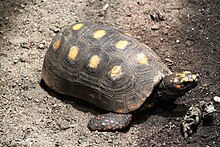| Red-footed tortoise | |
|---|---|

| |
| Scientific classification | |
| Domain: | Eukaryota |
| Kingdom: | Animalia |
| Phylum: | Chordata |
| Class: | Reptilia |
| Order: | Testudines |
| Suborder: | Cryptodira |
| Superfamily: | Testudinoidea |
| Family: | Testudinidae |
| Genus: | Chelonoidis |
| Species: | C. carbonarius
|
| Binomial name | |
| Chelonoidis carbonarius | |
| Synonyms[2] | |
The red-footed tortoise (Chelonoidis carbonarius)[2] is a species of tortoise from northern South America. These medium-sized tortoises generally average 30 cm (12 in) as adults, but can reach over 40 cm (16 in). They have dark-colored (nearly black), “loaf”-shaped carapaces (top shell) with a lighter patch in the middle of each scute (shell segment), and a somewhat lighter-colored plastron (underbelly). They also have dark limbs dotted with brightly-colored scales, from which they get their name, that range from pale yellow to vivid or dark red. Visible differences are noted between red-footed tortoises from varying eco-regions. They are closely related to the more easterly-distributed yellow-footed tortoise (C. denticulatus) of the Amazon Basin.
Their natural habitat ranges from savannah to forest edges around the Amazon Basin. They are omnivorous tortoises, consuming a wide assortment of plants, grasses, flowers, fruit and (notably) fungi, as well as the occasional earthworm or other invertebrate. When presented with the opportunity, many tortoises will also scavenge on carrion. They do not brumate, due to their equatorial home range, but may aestivate in the hotter, drier months.
Red-footed (and yellow-footed) tortoises are popularly kept as pets. Over-collection of eggs, and the capturing of mature animals, from their native habitat has caused them to be listed as “vulnerable” to extinction, despite the relative ease of captive breeding and the availability of captive-bred tortoises. Additionally, many remote tribal groups living in South America still consider the tortoises a basic source of meat, and many are unaware of the species’ overall plight; many travelers and activists report seeing live red-footed tortoises for sale in markets where bushmeat and live animals are sold. Eggs, hatchlings, and even mature tortoises are food for many animal predators, including caimans, crocodiles and giant otters (if near water), as well as birds of prey, bushdogs, jaguars, jaguarundis, margays, certain monkeys, ocelots, pumas and tayras. Population density ranges from locally common to very scarce due, in-part, to habitat destruction and the aforementioned over-collection for food and the pet trade.
The species name has often been misspelled as carbonaria, an error introduced in the 1980s when Chelonoidis was elevated to genus and mistakenly treated as feminine, an error recognized and fixed in 2017.[2]
- ^ Spix, Johann Babtist. 1824. Animalia Nova sive Species Novae Testudinum et Ranarum. Monachii: 53 pp.
- ^ a b c d Turtle Taxonomy Working Group; Rhodin, A.G.J.; Iverson, J.B.; Bour, R.; Fritz, U.; Georges, A.; Shaffer, H.B.; van Dijk, P.P. (2017). "Turtles of the World: Annotated Checklist and Atlas of Taxonomy, Synonymy, Distribution, and Conservation Status" (PDF). In Rhodin, A.G.J.; Iverson, J.B.; van Dijk, P.P.; Saumure, R.A.; Buhlmann, K.A.; Pritchard, P.C.H.; Mittermeier, R.A. (eds.). Conservation Biology of Freshwater Turtles and Tortoises: A Compilation Project of the IUCN/SSC Tortoise and Freshwater Turtle Specialist Group. Chelonian Research Monographs. 7 (8th ed.). pp. 1–292. doi:10.3854/crm.7.checklist.atlas.v8.2017. ISBN 978-1-5323-5026-9. Retrieved 14 October 2017.
- ^ Gray, John Edward. 1830. A Synopsis of the Species of the Class Reptilia. In: Griffith E. and Pidgeon, E. The Class Reptilia arranged by the Baron Cuvier, with specific descriptions. In: Griffith, E. (Ed.). The Animal Kingdom Arranged in Conformity with its Organization, by the Baron Cuvier, with Additional Descriptions of all the Species Hitherto Named, and of many not before Noticed. Vol. 9. Reptilia. Supplement. London: Whittaker, Treacher, and Co., 110 pp. [Part 26, published Dec 1830].
- ^ Wagler, Johann Georg. 1833. Descriptiones et Icones Amphibiorum. Tres partes cum XXXVI tabulis. Monachii: J.G. Cottae, 30 plates.